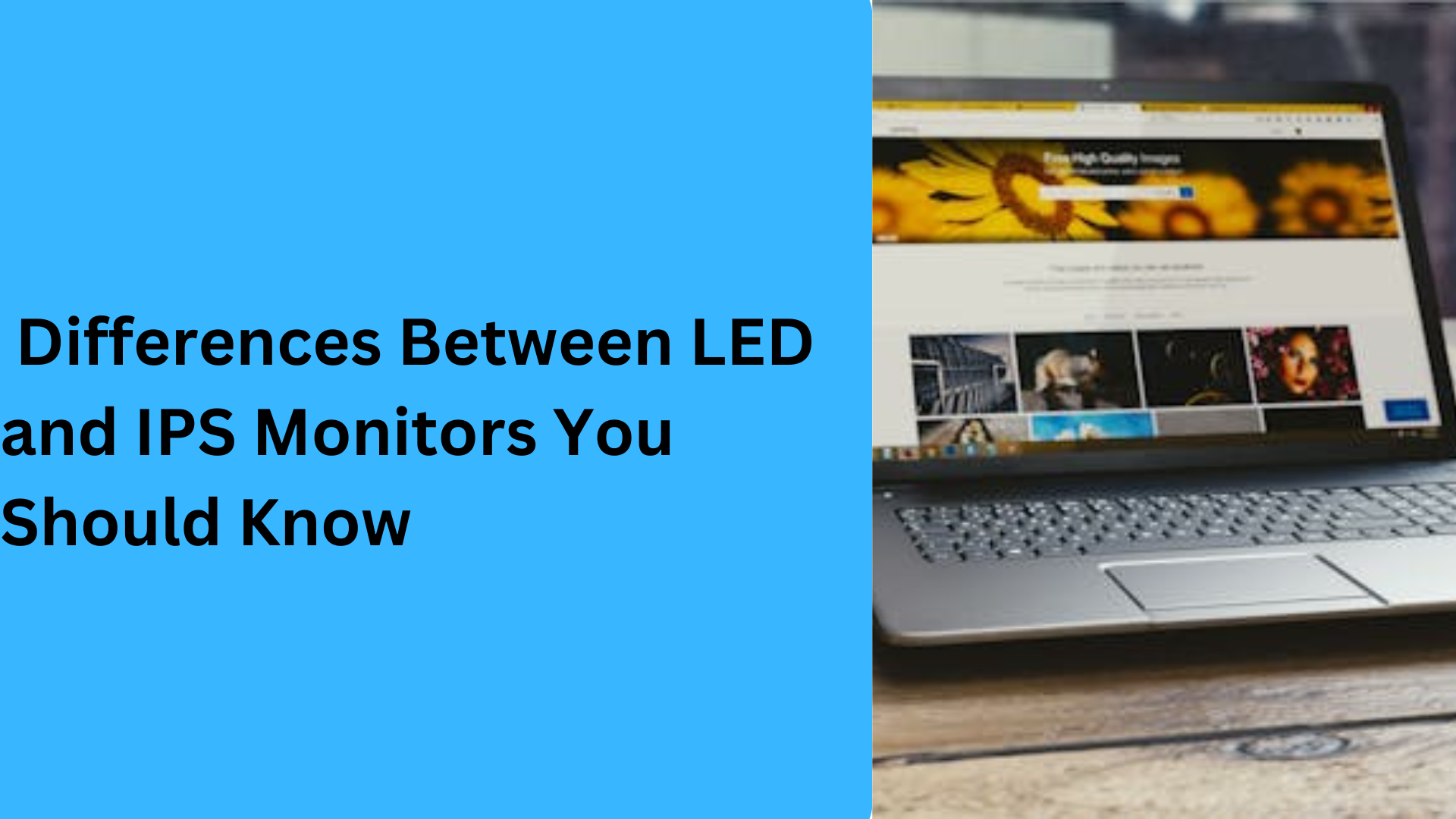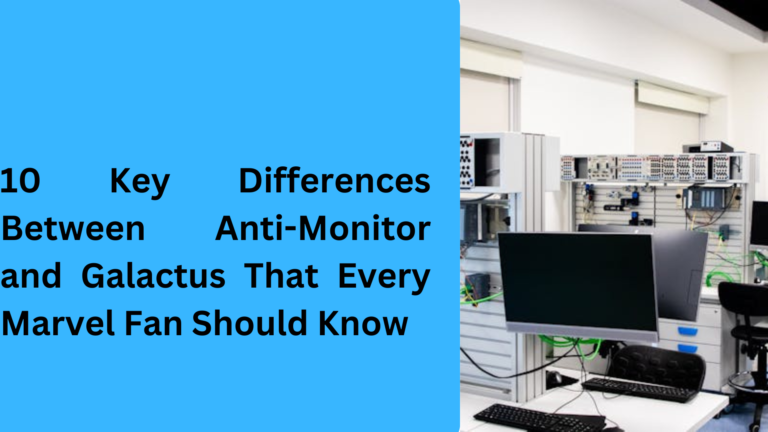10 Key Differences Between LED and IPS Monitors You Should Know
When choosing a monitor, it’s essential to understand the differences between LED and IPS technologies. Whether you’re buying a new monitor for gaming, work, or general use, knowing how LED and IPS monitors differ can make a big impact on your experience. Here are five important differences that should guide your decision-making process.
1. LED vs IPS Monitors: What is the Main Difference in Display Technology?
The primary difference between LED and IPS monitors lies in the display technology. LED monitors use light-emitting diodes to backlight an LCD panel, offering better brightness, energy efficiency, and slim designs. On the other hand, IPS (In-Plane Switching) monitors are a type of LCD panel technology that improves upon traditional LCD by offering superior color accuracy and wider viewing angles.
While both types of monitors feature LCD display panels, IPS technology stands out for its improved color reproduction and consistent viewing experience, making it ideal for tasks where accurate colors are important, such as photo editing or video production.
2. Color Accuracy and Image Quality: LED vs IPS Monitors for Creative Work
For tasks requiring color precision, like photo editing, graphic design, or video editing, an IPS monitor is a better choice than an LED monitor. IPS panels provide superior color accuracy and maintain color consistency even when viewed from wide angles. In contrast, LED monitors often struggle with color fidelity and can have distorted colors at certain angles.
If you need a monitor for creative work, IPS display technology will give you vibrant, consistent colors. LED monitors may still produce decent colors but can’t match the level of accuracy found in IPS panels.
3. Viewing Angles: Why IPS Monitors Are Ideal for Group Work or Multimedia
One of the biggest advantages of IPS monitors is their wide viewing angles. Whether you’re watching a movie, playing a game, or collaborating on a project, the image remains clear and consistent from any angle. LED monitors, especially cheaper models, may have limited viewing angles, meaning the image can look washed out or distorted when viewed from the side.
If you’re working in a team setting or want to enjoy movies with multiple viewers, an IPS monitor will provide a more satisfying experience. With IPS technology, you can share the screen without worrying about losing image quality.
4. Brightness and Energy Efficiency: How LED Monitors Stand Out
When it comes to brightness and energy efficiency, LED monitors have the upper hand. LED backlighting allows these monitors to be brighter and more energy-efficient than their IPS counterparts. This is ideal for office work, where you might need a monitor that can cut through bright ambient light or save on energy consumption over time.
While IPS monitors offer great image quality, they tend to consume more power and may not be as bright in comparison. For general use or if you’re looking for a budget-friendly monitor with low power consumption, LED monitors are a great option.
5. Response Time and Refresh Rate: Which is Better for Gaming?
If you’re a gamer or someone who needs a fast response time, LED monitors are typically a better option. LED technology generally offers faster response times, which is crucial for fast-paced gaming where every millisecond counts. Additionally, LED monitors often support higher refresh rates, making them ideal for competitive gaming or tasks like video streaming.
IPS monitors, while excellent for color accuracy and wide viewing angles, often have slower response times than LED monitors, which might not be ideal for gamers seeking smooth, lag-free performance. However, high-end IPS monitors are available with better response times and refresh rates, but they are generally more expensive.
6. Durability and Lifespan: Which Monitor Lasts Longer – LED or IPS?
When considering the longevity of your monitor, LED monitors often come out ahead due to their energy-efficient design. The LED backlight in these monitors is more durable, meaning they can often last longer without significant dimming or color degradation over time. LED displays tend to be more resistant to wear and tear from constant use, making them a solid choice if you want a monitor that can last for years without major issues.
In contrast, IPS monitors—while durable in terms of image quality—may experience slight color shift over time. However, they still offer excellent durability compared to older display technologies. For long-term use, LED monitors may offer a slight advantage in terms of lifespan, especially for more budget-conscious buyers.
7. Price Range: LED vs IPS Monitors for Different Budgets
Price is a significant factor when choosing between LED and IPS monitors. LED monitors tend to be more affordable, especially for basic needs such as office work, general browsing, or light gaming. Since LED monitors use less expensive technology for backlighting, they are a popular choice for those with a limited budget.
IPS monitors, on the other hand, tend to be more expensive due to the advanced technology that offers superior color accuracy, wide viewing angles, and image clarity. If you’re on a tight budget but still need decent performance for everyday tasks, an LED monitor is a great value for the money.
However, if you need a premium display for work that requires color precision or enjoy high-definition content, investing in an IPS monitor might be worth the extra cost.
8. Size Options and Flexibility: LED vs IPS Monitors for Different Applications
When considering the size of the monitor, both LED and IPS monitors are available in a wide range of sizes to suit different tasks. LED monitors are often available in larger sizes at a more affordable price, making them ideal for home offices or living rooms where a bigger screen is desired without the high price tag of larger IPS panels.
IPS monitors, while available in a variety of sizes, are typically more focused on premium offerings for users seeking high-end performance. If you need a large monitor for creative work like video editing or graphic design, you may find that IPS technology offers better color accuracy at those larger sizes. LED monitors often provide more budget-friendly large-screen options, making them a great choice for general use.
9. Flicker-Free Technology: How LED vs IPS Affects Eye Comfort
If you’re concerned about eye strain or fatigue from long hours of screen time, it’s important to consider flicker-free technology in both LED and IPS monitors. LED monitors can sometimes cause flickering due to the PWM (pulse-width modulation) used to control brightness, leading to discomfort for some users after extended use.
IPS monitors, particularly those with flicker-free technology, often provide a more comfortable viewing experience with less flicker. This makes IPS monitors a better choice for professionals or students who spend many hours on their screens. However, many LED monitors now also come with flicker-free technology, so it’s worth checking the specifications before purchasing.
10. Gaming Experience: LED vs IPS Monitors for Different Types of Gamers
For gaming enthusiasts, the choice between LED and IPS monitors can come down to a variety of factors, including response time, refresh rate, and overall gaming performance. If you play fast-paced games that require quick reflexes, such as first-person shooters (FPS), an LED monitor might be your best bet due to its faster response times and often higher refresh rates.
However, if you’re someone who enjoys immersive experiences in story-driven games or open-world games, an IPS monitor may be a better choice. IPS displays provide more vibrant colors and better contrast, which makes games look more detailed and realistic. In recent years, the gap between LED and IPS monitors for gaming has narrowed, with high-refresh-rate IPS panels now available, but LED monitors remain a popular choice for competitive gamers due to their faster speeds.
1. What is the difference between LED and IPS monitors in terms of color accuracy and image quality?
When comparing LED monitors and IPS monitors for color accuracy, IPS displays tend to provide better color consistency and more precise color reproduction, making them ideal for tasks like photo editing, video production, and graphic design. LED monitors offer decent image quality but may struggle with color fidelity and suffer from distorted colors when viewed at certain angles. For users who prioritize accurate color representation and wide viewing angles, IPS monitors are the better choice.
2. Which monitor is better for gaming: LED vs IPS?
If you’re a gamer looking for a fast and responsive monitor, LED monitors generally have a faster response time and higher refresh rates, making them ideal for competitive gaming or first-person shooters (FPS). However, if you prefer an immersive gaming experience with better colors and contrast, IPS monitors are the way to go. IPS technology provides vibrant colors and excellent viewing angles, making it perfect for story-driven or open-world games. There are also high-refresh-rate IPS monitors available, so gamers can enjoy both performance and visuals.
3. Do LED monitors last longer than IPS monitors?
In terms of durability and lifespan, LED monitors often have an advantage. The LED backlighting is typically more durable, meaning these monitors can last longer without significant dimming or color degradation. While IPS monitors provide excellent image quality, they can experience slight color shifts over time. For those looking for a long-lasting, energy-efficient monitor, LED monitors are usually a better choice, though both types of monitors can last for several years with proper care.
4. Are IPS monitors more expensive than LED monitors?
Yes, IPS monitors tend to be more expensive than LED monitors due to their superior color accuracy, better viewing angles, and overall image quality. IPS technology is generally used in premium displays, making it the go-to choice for professionals in fields like photography, design, and video editing. LED monitors are usually more affordable and are suitable for general tasks like office work or casual gaming. If you’re on a budget but still need a good monitor, LED displays are a great value.
5. Which monitor is better for watching movies: LED or IPS?
For watching movies, IPS monitors are typically the better choice. The wide viewing angles and better color accuracy of IPS panels provide a more immersive and enjoyable viewing experience, especially for movies with vibrant colors and detailed visuals. LED monitors, while still good, may not offer the same level of visual richness, and their narrower viewing angles could lead to a loss of color quality when viewed from the side. If you’re a movie enthusiast looking for cinematic visuals, an IPS monitor will deliver superior results.


